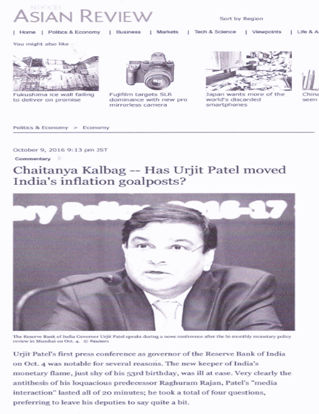Has Urjit Patel moved India’s inflation goalposts?
Published date: 9th Oct 2016, Nikkie Asia Review
The Reserve Bank of India Governor Urjit Patel speaks during a news conference after the bi-monthly monetary policy review in Mumbai on Oct. 4. © Reuters
Urjit Patel’s first press conference as governor of the Reserve Bank of India on Oct. 4 was notable for several reasons. The new keeper of India’s monetary flame, just shy of his 53rd birthday, was ill at ease. Very clearly the antithesis of his loquacious predecessor Raghuram Rajan, Patel’s “media interaction” lasted all of 20 minutes; he took a total of four questions, preferring to leave his deputies to say quite a bit.
This is not a surprise. Deepak Parekh, an eminent banker and chairman of India’s Housing Development Finance Corporation, who worked closely with Patel at the Infrastructure Development Finance Company between 1997 and 2006, said in a recent media interview: “Well, he is a quiet person… some people say he is a loner, but he is conservative. He is a man of few words. He will not be giving many interviews because I ‘think he is a little shy.”
Patel also did not grant a single post-policy interview to any journalist. This was in sharp contrast with both Rajan and Rajan’s predecessor Duvvuri Subbarao, who were frequently seen and heard. Patel has not delivered a single speech in his five weeks in office. Interestingly, Rajan kept talking until his final day in the office. His Sept. 3 speech was fittingly titled: “The independence of the central bank.” That independence has been sharply whittled down by a newly created six-member Monetary Policy Committee. Under Patel’s chairmanship, the MPC met for two days before announcing on Oct. 4 a 6-0 vote in favor of an interest-rate cut.
The RBI’s announcement of a 25 basis-point cut in the benchmark repo rate took almost everyone by surprise. The cut was counter intuitive. Six out of 10 bankers in advance surveys had forecast the RBI would hold rates steady at 6.50%. The central bank has now cut the key lending rate by 175 basis points since January 2015.
As one senior economist noted, Patel has “thoroughly confused the public … he has moved the goalposts.” The bewilderment is because India’s consumer price index inflation has stayed stubbornly above the RBI’s 5% target for March 2017. Driven by higher food prices it even rose to 6.07% in July before falling back to 5.05% in August. Rajan had been steering the RBI on a “glide path” toward a single-point goal of 4% CPI inflation by March 2018.
Two points at Patel’s press conference appeared to underline a more dovish approach to inflation targeting and a move away from Rajan’s more fierce approach, even if it meant a small trade-off with growth.
First, Patel was at pains to put emphasis on the 4% plus-or-minus 2% band legislated in the new RBI Act. “[The] RBI indicated its resolve to contain inflation through self-imposed targets and framework agreement with the government. Now, all those ad hoc measures are superseded by the legal amendment,” he said in his press conference.
In other words, as Nomura Securities noted in a recent report, Patel seemed to have tweaked the framework to aim for a 2% to 6% inflation band from a single-point target of 4%. “In fact, our main takeaway from today’s policy meeting is that there has been a dilution of the tenets of the flexible inflation targeting framework under the new RBI [Patel] compared with the old RBI [Rajan]” Nomura said.
Sonal Varma, Singapore-based India chief economist at Nomura, told the Nikkei Asian Review that the inflation band could technically permit anything from a 3% inflation rate to a 5.8% inflation rate. “From the perspective of investors, households, analysts – it’s too wide a range. What are we targeting – 2% to 6%? Are we going to get to 4%?”
India’s inflation is among the highest as well as fastest growing among in emerging Asian economies. and is also growing at the fastest rate. Globally, inflation is not only on a downward curve, but several countries are fighting deflation, oil prices are down, the output gap is negative, and bank balance sheets are negative. “This is as good as it gets to keep inflation low,” Varma added. “The bigger challenge in India is expectations.”






